This post contains affiliate links. We may get paid an affiliate commission if you buy something or take an action after clicking one of the links on this web page.
The Blackwater Grizzly 6 is another knife in a new line up by California-based cutlery company Blackwater Knives. The Grizzly 6 is designed by Robert Young Pelton and Tom Novak, and is manufactured for Blackwater by LionSteel in Maniago, Italy. The end result is a sleek Italian fighter packed with rugged features.
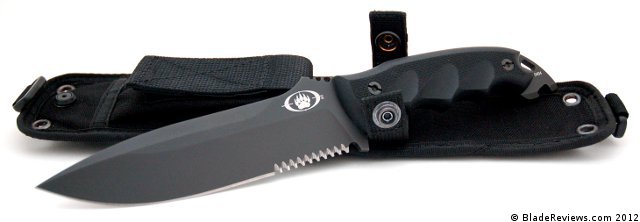
Buy the Blackwater Grizzly 6 at BladeHQ
The Grizzly 6 shares many similarities to the previously reviewed Blackwater Ursa 6. Both knives are approximately the same size, and share similarities in both their aesthetic and practical considerations. That said, the Grizzly 6 is very much it’s own knife, and deserves it’s own equally thorough examination.
General Dimensions and Blade Details
The Grizzly 6 has an overall length of 11.18″, features a 6″ blade, and weighs 10.23 ounces. The knife was designed specifically for SERE (Survival, Evasion, Resistance and Escape) training. SERE certification involves survival training for the U.S. military, and involves the intersection of a number of different disciplines important in overcoming both the physical and mental challenges of a survival situation.
Ultimately, for a knife to perform well in this kind of situation it needs to be versatile, and I see the Grizzly 6 as something that would work well as a combat knife, a camp knife, and a survival knife all rolled into one. The knife is strong without being overweight, has enough size to be used in both a defensive and offensive role, and can be easily thrust into a utility role as well.
The blade on the Grizzly is a robust modified drop point design. I really like the bold lines and aggressive belly, it makes for a very striking profile as well as a useful tool. The blade has been given a high flat grind that is reinforced through the tip, and bolstered with a swedge. The 5mm thick piece of steel is ground thin enough to get work done, but also holds up nicely to light chopping, prying, digging, and general use and abuse. Blackwater included serrations on this model, not my first choice personally, but apparently serrations are very important / desirable to the military personnel ultimately using this knife. Consider the DPx HEFT 6 if you like this size and style of knife, but prefer a completely plain edge.
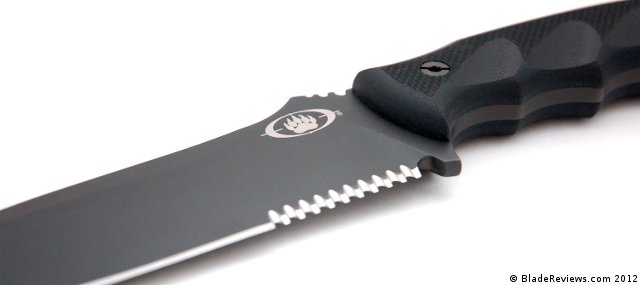
Blackwater went with Niolox steel for the Grizzly 6. This is a stainless German tool steel that I am slowly gaining more experience with. It’s manufactured by Bohler Uddeholm, and I generally characterize it as a tough steel that takes a nice edge and holds onto it over a good amount of use. I cut leather, rope, cardboard, and wood with this knife and the edge held up well. I experienced no issues with chipping, bending, or rolling – even after prying the knife through a 2×4.
I sharpened the Grizzly on some ceramic stones from my Spyderco Sharpmaker and found that the Niolox quickly came back to life – a must if you happen to be in the field potentially miles away from the creature comforts of modern sharpening equipment. I had no issues with staining, and noticed that the black PVD coating Blackwater used held up well. All in all I think Niolox was a nice choice for this knife, and I am starting to develop a healthy amount of respect for this steel.
Handle and Ergonomics
The Grizzly features a 5mm thick full-tang handle sandwiched between two generous slabs of black peel-ply G10. This is an impressively rugged handle that also has a good deal of refinement. For example, the spine of the handle has been capped (rounded) for comfort. Capped spines are a feature typically reserved for high end knives like the Chris Reeve Sebenza, so it is awesome to see it here. The handle scales are fully removable with a flat head driver, and reveal a hollow handle perfect for the storage of small survival items. The pommel features an extended striking portion that can be used as a “non-lethal” defensive option as well as a pry bar, bottle opener, and lanyard hole.
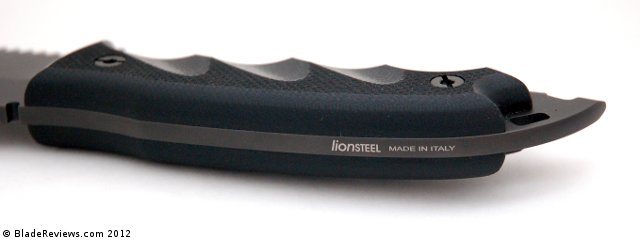
In hand the Grizzly feels fast and comfortable. The balance point is right where the handle meets the blade giving the knife easy control with the turn of a wrist. The peel-ply (roughly textured) G10 provides good traction while aggressive finger grooves lock your hand in place. I was concerned that these grooves would be too aggressive to accommodate all hand sizes, but in practice I found the Grizzly quite comfortable in a variety of tasks.
There is a short run of jimping on the thumb ramp. In reviewing the Ursa 6 I found this style of jimping (that doubles as wire stripper) to be uncomfortable under harder use. Here, I don’t have the same issue because I can always put my thumb on the spine of the blade itself. The Grizzly 6 also feels very comfortable in reverse grip. All in all, the ergonomics on this knife are quite nice.
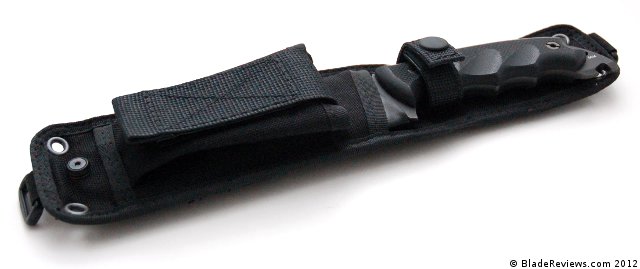
Sheath
The Grizzly 6 arrives with a heavy duty cordura sheath. It’s a lightweight sheath, ideal for weight conscious SERE Specialists, yet fully functional and very versatile. There is a fully reversible plastic liner allowing for left or ride side carry. There are multiple mounting points on the top and bottom of the sheath and the fully MOLLE compatible backing integrates with both MOLLE gear or a regular belt. There is an external pouch for extra storage, and a secondary retention strap to insure your blade stays where you want it. In practice I found this to be a well thought out sheath and was nicely executed by the folks at LionSteel.
I carried the Grizzly on my belt and had no issues with with the sheath. Blade retention is good, and I like how the secondary retention strap is mostly made of plastic – that makes the strap ultra durable and unlikely to get badly cut under use (especially when quickly drawing the knife from the sheath). Sure, a heavier kydex sheath is always an option, but I think this sheath gets the job done without a lot of excess weight or baggage.
Blackwater Grizzly 6 Review – Final Thoughts
The Grizzly 6 is an attractively made tool, and I don’t doubt that many will initially be drawn its bold lines and thick proportions. I’m happy to report that the knife performs just as good as it looks. The materials here are of exceptional quality. I am starting to really appreciate Niolox tool steel, while both G10 and Cordura have become industry standards. The fit and finish is outstanding. LionSteel is capable of making some amazing stuff, and this is a beautifully made knife that could work well in a collection, but is ultimately designed for real world use.
In practice I found that the knife cut well and felt comfortable. The balance lends itself to self defense and utility more than heavy chopping, and I found the Grizzly to be capable in many different tasks. The sheath is lightweight and durable – it should fit the needs of most people without issue.
I don’t have any military or SERE experience, so it’s very difficult for me to recommend a knife specifically for that role, but if you are in need of a capable fixed blade knife, a knife that is of high quality and is well rounded, then I can safely say that the Grizzly 6 is an awesome tool that should hold up really well in a wide variety of roles. When you toss in Blackwater’s 2 year insurance policy for active duty U.S. military, the value becomes even more apparent. This is another winner from Blackwater in my book with their bold take on the classic combat knife.
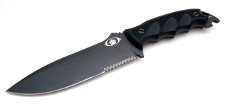
Blackwater Grizzly 6 – $250
From: BladeHQ
I recommend purchasing the Ursa 6 at Amazon, or BladeHQ. As always, thanks for reading. Please let me know if you have any comments or questions in the comments section below.
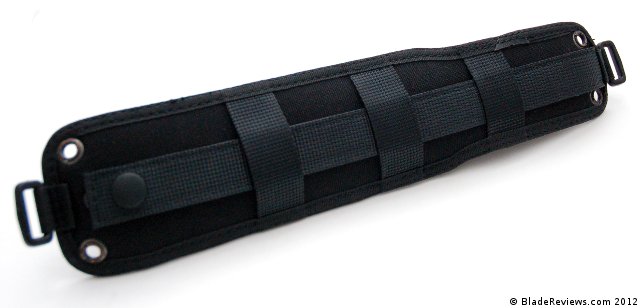
I was curious why you say the Grizzly 6 would serve as a camp knife and a survial knife but you don’t feel the Ursa 6 would. I am a novice but the two knives seem very similar in design. Can you please explain?
Hi Steve,
First of all, thanks for the excellent question. In my opinion the Ursa 6 is more of a purpose built weapon/breaching tool. The edge / blade geometry is much thicker / stouter which means it will have more resistance when using it as a utility knife, and the shape is pointier and more resembles a dagger. That, and the serrations on the spine, all make me hesitate to classify the Ursa 6 as a camp or survival knife. Sure it could be used as such in a pinch, but if you are looking for something for camping / outdoor work I’d say the Grizzly 6 is better suited for those applications. Hope this helps clarify.
Thanks again,
Dan
Major sale on the knife @ BladeHQ now!!
Damn! That is a good deal! Thanks for the heads up, Art.
Dan,
Thanks for the fine review. Your explanation to Steve was right on the money. This blade is definitely geared toward the backpacker/bushwhacker individual. I like it better than the Ursa 6 but I still worry about those finger grooves. Everyone has a unique hand and grooves just seem to limit your hold especially under stressful conditions. Still a great knife, thanks again.
Thanks, Nick. I can understand your concern. I would definitely recommend that you try before you buy with the Grizzly, as the finger grooves could be uncomfortable for some people. That said, this is a cool knife and there is still a lot to like about it.
Best,
Dan